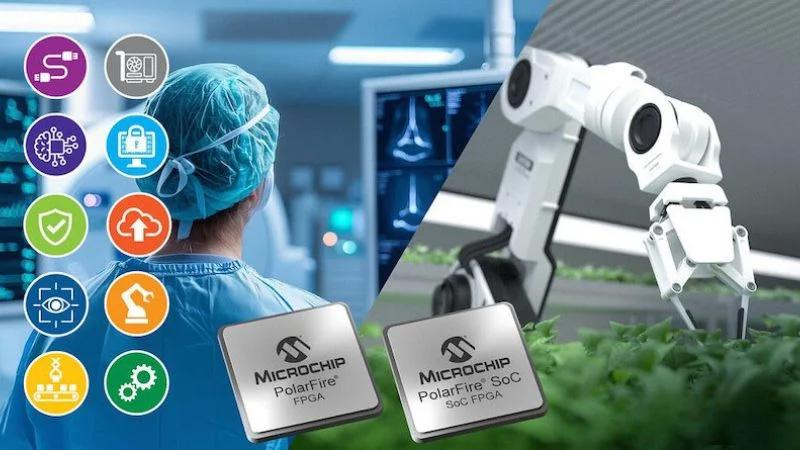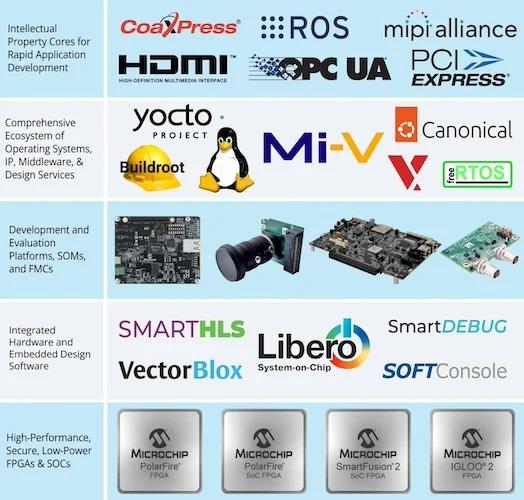Microchip Unwraps PolarFire Solution Stacks for Imaging and Robotics
Microchip has announced a set of field-programmable gate array (FPGA) and system-on-chip (SoC) solution stacks to speed the development of applications using PolarFire FPGAs and SoCs. Solution stacks are modular resources created to make advanced FPGA development easier.

Solution stacks speed development for a wide variety of applications.
Designing with modern FPGAs and SoCs is a complex undertaking. Tight schedules and labor shortages compound the challenges that organizations face. Solution stacks, like the new set from Microchip, ease that burden by reducing the development overhead.
The solution stacks are built around low-power, high-performance PolarFire, PolarFire SoC, SmartFusion 2, or IGLOO 2 FPGA chips. The sets include integrated logic design tools, IP cores, software design stacks, libraries, compilers, operating systems, validation tools, and optional evaluation boards.
Targeting PolarFire FPGAs and SoCs
Microchip designed its PolarFire FPGAs and SoCs to fit mid-range logic cells with high reliability, low power consumption, and "best-in-class" security. Being lower power, the chips also require less stringent cooling.
PolarFire FPGAs range in cell count from 100,000 to 500,000 logic elements, have 12.7-G transceivers, and consume less than 50% of the power of competing products. PolarFire SoCs add to the FPGA fabric with a five-core, Linux-capable RISC-V processor and a generous peripheral and I/O set.
The RISC-V cores are architected specifically for robot operating system (ROS) 2 compatibility. ROS 2 is an open-source robotics toolchain with more than ten years of development and use. ROS 2 gives smart robot developers a familiar framework with global support. The OS assists with basic robotic functionality, robot autonomy, back-end systems management, and device user interfaces. It has a broad and growing set of libraries covering sensors, mechanics, and algorithms.
Elements of a Solution Stack
IP blocks: The stack includes a variety of pre-designed modular functions in IP block form. These include interfaces such as AI-assisted 4K60 computer vision, a diverse set of ready-to-use sensor and camera interfaces, and integrated hardware for high-speed Ethernet protocols.
Operating systems: Linux and other operating systems, including real-time OSes like ROS-2 and OPC/UA rich operating systems, along with middleware, can be packaged into the stack.
Evaluation hardware: The stack has options for generic development boards and application-specific boards, such as video processors.
Toolchains: The Microchip solution stack includes toolchain options with multiple languages, such as C/C++ and RTL, and popular machine learning frameworks, including the SmartHLS IDE, VectorBlox Accelerator SDK, and the Libero SoC Design Suite.
FPGAs and SoCs: The complete line of PolarFire FPGAs and SoCs are compatible with the new solution stacks.

Options available with the Microchip solution stack.
Vertical Solution Stack Options
Microchip includes several vertical application-specific solution stacks to speed PolarFire adoptions in targeted industries. Two highly developed stacks address smart robotics and medical imaging.
Microchip developed the smart robotics stack to improve development cycles for smart industrial robots. Key development modules cover functionality such as smart embedded vision (SEV), multi-axis motor control, time-sensitive networking (TSN), OPC UA, ROS 2, machine learning (ML), and safety functionality. Covering these core features of a smart robot can reduce the barrier to entry for developers and speed up the path to higher-quality products.
The medical imaging solution stack addresses the many opportunities for machine vision in the medical industry. Devices such as MRIs, CT scanners, ultrasounds, endoscopes, and medical robots rely heavily on vision systems. While FPGAs and SoCs are useful for the imaging processing and sensor fusion required for these devices, programmable logic development can be complex, difficult to verify, and time-consuming. The solution stacks may give developers a significant head start with pre-built and pre-verified modules.
Modules for Faster, More Reliable Development
With an FPGA processing sensor input, all data can be collected and processed in parallel. The motion output can also be enacted simultaneously. FPGA-based circuitry can easily be massively parallel, leading to significant improvements in robot response times.
As both the internal components and the external applications become more complex, developers need better development tools. The Microchip solution stacks are a direct answer to that need. The solution stacks will make the development and deployment of PolarFire chips an easier choice for mixed-application programmable logic developers.
Sign up to our newsletter
Receive our latest updates about our products & promotions
